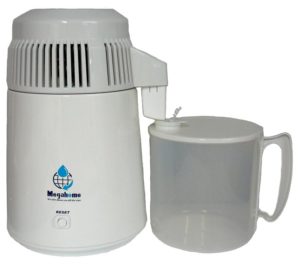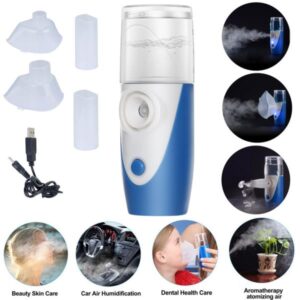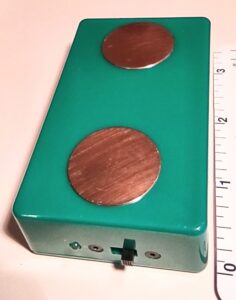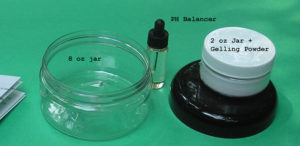Reports about a user of colloidal silver turning blue have neglected to state the type of CS used, the concentration, and amount ingested. When made properly and taken in reasonable amounts, CS does not cause bluing of the skin nor does it result in heavy metal poisoning. If this could happen, we would have seen many cases instead of perhaps the five or so reported, none of whom used properly made CS. MIllions of people use CS regularly. If argyria really happened, we would have seen many cases by now. The few reported cases used silver nitrate or extremely strong, improperly made CS taken in excessive amounts over long periods of time. The FDA knows this and would have banned CS if argyria happened more than once in a very blue moon.
A note from Phil Safier, President of Elixa: “I have used CS daily for over 20 years in amounts ranging from 1 ounce to as much as 16 ounces a day when called for. I have not turned blue nor have I ever heard of anyone else turning blue after using properly made CS.”
Silver solutions work internally and externally, do not build up in tissue, and prevent and cure infections and diseases that often do not respond to conventional medical treatments. In fact, hospitals use it on burns and other conditions, bandages contain it, even some paint and countertops now contain silver.
Excerpt from Colloidal Silver: The Natural Antibiotic
by Zane Baranowski, CN
(This clearly written, informative publication thoroughly explains colloids, ways of making colloidal silver, early uses, rediscovering the universal antimicrobial, visual qualities, safety and effectiveness, and modern day uses. It also has an excellent bibliography with references and resources.)
“Stability, especially long-term, is another important aspect of’ colloidal silver products. To avoid “fall out”, some companies add a protein or chemical stabilizer, allowing a higher concentration of silver with a greater level of stability. The downside is that most stabilizers bond to and therefore reduce the antimicrobial effect of’ silver. Such products contain higher levels ot total silver to compensate, and should he taken with caution because in all documented cases of silver toxicity, called Argyria (the permanent discoloration of the skin due to silver deposits), the product in question contained high concentrations of silver compounded with stabilizers such as silver nitrate or silver acetate. Argyria has never been reported from pure electro-colloidal silver free of protein or other stabilizers.
BEST COLLOIDAL SILVER
Within the last few years, a number of colloidal silver products have appeared on the market, confusing consumers. The best way to determine if a product is a true colloid of silver is to examine the ingredients. If it contains a stabilizer, or listed trace elements other than silver, the product may not be suitable. If the product requires refrigeration, it may contain some other ingredient that might spoil at room temperature.
The highest quality colloidal silver is produced by the electro-colloidal/non-chemical method. The silver particles and water have been completely “colloided” and evenly dispersed and held in suspension by an electrical current sent through the combination. This process is the only known method to create a truly homogeneous (evenly distributed) solution, containing super-fine silver particles in the range of 0.005 – 0.015 microns in diameter, suspended in water, without the need of any chemical, stabilizer, dye, or other ingredient.
There is very little or no visible accumulation of silver particles either in the solution or settled on the bottom. The best products will contain the largest number of particles from the smallest total amount of silver. (Note: an artificial electrical charge applied to any element, including silver, cannot be held infinitely – like a battery, its charge will dissipate. Therefore, electro-colloidal silver cannot be expected to have infinite shelf-life; some ‘fallout’ may occur in any non-stabilized product over an extended period of time.)
WHAT IS A COLLOID?
The term colloid (KOL’ OID) refers to a substance that consists of ultra-fine particles that are suspended in a medium of different matter (i,e. a non-soluble mineral suspended in water). The particles in a colloid are typically 0.01 to 0.001 of a micron in diameter, or about four hundred thousandths to four millionths of an inch. Approximately one billion of these particles could fit into a cube four one hundredths of an inch in size.
Of the five manufacturing processes, the grind process and the electro-colloidal process were primarily used to manufacture colloidal silver. Today, the FDA still allows both manufacturing techniques to be used. However, of these two methods the electro-colloidal manufacturing process is generally considered to be far superior. With the grind method, the particles of silver are usually no finer than four one-thousands of an inch. They may or may not be electrically charged. The size of the silver particle is so large compared to the possible charge, that the repelling forces would not be strong enough to offset the pull of gravity on the particles, which will tend to settle to the bottom of the solution, producing a less effective product.
Stabilizing Additives
To offset this settling problem, some manufacturers add a “stabilizer” (usually a protein) to make the solution more viscous and keep them suspended for a longer period of time. The silver particles will still eventually settle to the bottom. The container will have to be shaken to redisperse the particles. However, stabilizers tend to block the beneficial effects of the silver particles.
Other procedures used in producing colloidal silver that involve a simple mixture of metal and liquid (grind process) cannot possess as much potential as electro-colloids and are therefore of questionable value. The proper electrical process allows silver particles to be drawn off the ingot that are much smaller than four one-thousandths of an inch diameter. If the silver particles are within the range of four one-hundred-thousands to four one-millionths of an inch in diameter, and are uniformly charged, a stabilizer is not required to keep the particles suspended. The repelling magnetic force will offset the pull of gravity on the particles, which are animated by “Brownian Movement”, and remain in suspension in a liquid medium almost indefinitely, their stability depending on the size of’ the particles, the medium used and the manufacturing process employed.
Visual Qualities
One indicator of the quality of colloidal silver is its color. As the size of each silver particle gets larger, the color of the suspension ranges from yellow (best) to brown, to red, to gray, to black (inferior). The increasing size of the particles also reflects a proportionate decrease in quality of the product. Colloids of silver that are produced using the electro-colloidal method are a different color than the grind or chemical method forms of colloidal silver. That rule generally applies, except in the case of some brands that use an artificial yellow dye to falsify the proper color. Color variance also depends on concentration, stabilizers, and the presence or absence of other trace elements. The ideal form of colloidal silver will be almost colorless or have a very light yellow color.
Besides buying from a reputable company and visually checking the color of the product, another quick way to see if a solution contains colloids is by observing the Faraday-Tyndall cone effect. When a sharp and intense hearn of light passes through a colloid solution, the path of the light will appear to be turbid. The path of the light is also altered. The path of the light will form a cone shape within the solution. The best way to observe this is to take a test tube of’ colloidal silver into a dark room and shine a very bright flash light through it. Colloids will appear to be milky. (Note: a discussion can be found in Jirgensons and Straumanis’ book titled “A Short Textbook of Colloid Chemistry;” New York: John Wiley & Sons, Inc; London: Pergamon Press Ltd.; 1954.)
Safety and Effectiveness
Specific documentation on the optimum potency or dosage for effective use is sparse. This has led to a wide range of products of varying potencies – all claiming to be the best. According to N.R. Thompson of Runcorn Health Laboratory in England, the concentration of silver necessary to sterilize water contaminated with pathogenic bacteria is between 40-200 gamma, or .04 to .2 ppm (1 ppm = 1000 gamma). In 1940 and 1966, respectively, R.A. Kehoe and I.H. Tipton reported that under normal circumstances the average daily diet will yield approximately 50mcg to 100mcg of silver. (Note: The reduction of silver in the average diet, due to commercial farming techniques, is similar to what has happened with other trace minerals including chromium, zinc and selenium – that are now known to be essential for good health. This reduction may play a role in the worldwide epidemic of chronic infections.)
Therefore, it seems logical that a concentration of 3 to 5 ppm, yielding 15 mcg to 25 mcg of silver per teaspoon, will be a sufficient concentration to be both effective and safe to consume on a regular, daily basis. A 4 oz. container of colloidal silver at a concentration of 3 ppm will contain approximately 355 mcg of total silver – well below any reported toxicity level of orally consumed silver – even if several ounces were consumed on a daily basis for several years. Higher concentrations above 5 ppm, or about 591 mcg of total silver in a 4 oz container, may cause silver build-up in the system and are not necessarily more effective, For example, a 25 ppm solution would yield 2.96 mg (2,960 mcg), a 500 ppm solution would yield 59 mg (59,000 mcg), a 5,000 ppm solution would yield 590 mg (590,000 mcg)! Any product containing higher concentrations, for example having higher levels than what could be found in the average daily diet, should definitely be taken with caution, only during a time of need and certainly not for extended periods.
The statement ‘less is more’ is often made when referring to colloidal silver and colloidal technology in general. What this means is that the number of silver particles determines the quality and effectiveness of colloidal silver, NOT simply the concentration. The term ‘ppm’ or ‘parts per million’ is confusing because it is not referring to the number of parts or particles, it is actually a different way to express total weight or total amount of silver. Since a colloidal product can have particles ranging in size from 1n to100n, it is difficult to judge the quality of a product by simply knowing the ppm. For example, a product with a concentration of 5 ppm with an average particle size of 5n would actually have more silver particles than another product of 25ppm with an average size of 50n and thus be safer and more effective.
Effects on Friendly Bacteria
Another advantage of correctly manufactured colloidal silver is that, with a particle size well below 1 micron (.015 to .001), a 3 to 5 ppm concentration of colloidal silver is unlikely to affect friendly intestinal bacteria. When taken orally, sublingual absorption in the mouth directly into the bloodstream should occur before the silver particles have the opportunity to migrate into the small or large intestine where intestinal bacteria normally dominate. However, in the case of a known intestinal infection, enemas or colonies of colloidal silver could be utilized to directly expose the infection to the sterilizing benefit of colloidal silver. Consumption of colloidal silver on a daily basis would significantly reduce the incidence of infection. The ability to do this safely could be a powerful preventive health measure to enhance the lives of millions of’ people susceptible to chronic infections. This is an opportunity only offered by properly prepared electrocolloidal silver that contains 99.9999% pure silver with no binding agents, stabilizers or proteins.”





